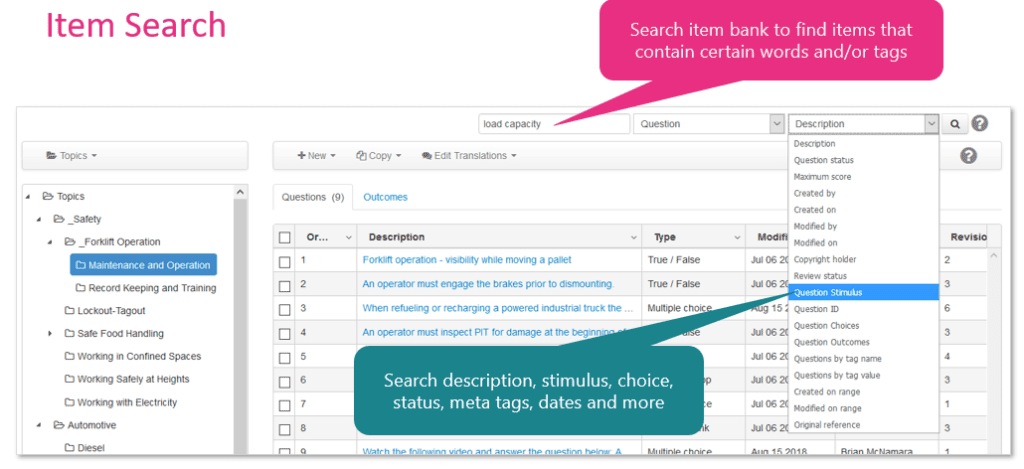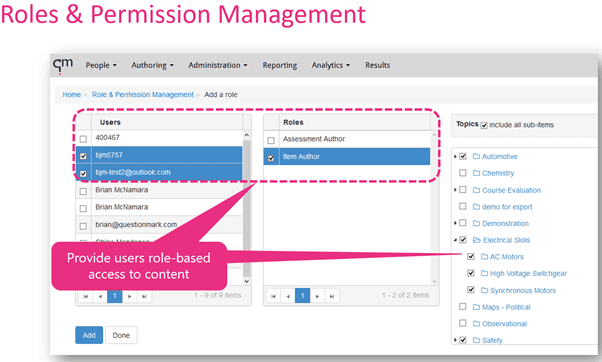The Item Bank
Why you do need an assessment management system like Questionmark? Why can’t you just use a learning management system (LMS) or e-learning system to create and manage tests and exams? One of the most compelling reasons is the value of an “item bank” to store questions in.
An “item bank” is the name for an indexed question repository or database for questions (also called “items”) from all your tests.
Some e-learning authoring systems, LMSs and course management systems let you build tests by storing questions alongside learning content or within a course. This works well on a small scale but gets harder the more tests you have and the more they change over time. Without an item bank, it’s very hard to manage and deliver reliable assessments at any scale.

Reasons for an Item Bank
Here are 10 reasons why an item bank is invaluable.
1. Get more value from questions by using an item bank in multiple tests
The simplest benefit of an item bank is that it is easy to use a question more than once. When creating a test or exam, you pick questions from the item bank, and you can have the same question in multiple tests. This is tricky to manage if questions are stored in different places.
2. Search for questions that need updates or can be re-used
Once you have 1000s of questions, it becomes critical to be able to search and filter them. For example, if your company changes a product name that you are testing about, you need to be able to search for all questions with the old name to adjust.
Or when you create a new test, you need to find existing questions that might be useful in it. As shown in the screenshot below, Questionmark’s item search allows you to search the question description, stimulus, choices, meta tags and much more.

3. Align questions to topic or competency area
Frequently it’s useful to tag questions by the topic they are in, their difficulty level, the competency they cover, the objectives they meet and other such characteristics. An item bank allows you to organize questions hierarchically and tag them up with meta tags so that they can be found, selected and used as needed.
4. Keep records for defensibility purposes when questions are retired
Questions expire for all sorts of reasons – they become out of date, they get shared too widely, the item stats drop or they no longer match the assessment objectives.
When it comes time for a question to cease work, it’s useful to “retire” it. A retired question stays in the item bank but is no longer used. You can still reference it as evidence to defend past tests or to run statistics on.
5. Maintain integrity by being able to roll back questions
People make mistakes, even test authors! A good item bank keeps track of all changes to questions, and if a change needs unraveling, it will allow you to roll back to a previous version.
Get in touch
Find out more and unlock the full potential of your assessments.
6. Show an item audit trail for legal defensibility
Tests are used to make decisions about people, and you may need to defend that the questions used were constructed under a proper process. If you ever get challenged that a test is unfair, it can be critical to maintain question versions and record the construction history of each question in the test.
7. Reduce cheating risk by limiting access to questions
Sometimes authors or administrators share questions, either inadvertently or if they want to help their students.
An item bank allows you to set roles and permissions and limit access on a “need to know” basis. So, for example, authors in one department should not see questions being authored in another department. This reduces the risk of authoring leakage and potential test fraud.

8. Manage translations well
An item bank makes it practical to manage translations of questions into different languages. When you change a question, it can help you keep track of updating the translations. It’s very time-consuming to make multilingual tests without good item banking software.
9. Assessments that select at random from the item bank
It’s common to deliver assessments that select items at random from the item bank – using criteria to ensure topic coverage and similar question difficulty.
This gives a different test for each test-taker and allows someone to take a test more than once and see different questions. An item bank makes this easy to manage, and by updating the bank, you can add and remove questions over time without disrupting the test.
10. Make it practical for a team to collaborate on building a test
Perhaps the biggest benefit of an item bank is that it allows a team to work together to build questions and the test. Few projects nowadays involve just a single author and software like Questionmark’s allows collaborative authoring – separate logins, an audit trail of all changes, the ability to see a comparison “track changes” view of items and much more.
If you have a few hundred questions, an item bank is useful. Once you start having a few thousand, it becomes critical – and some Questionmark customers have hundreds of thousands of questions.
If you’d like to see a demo of the Questionmark system including our authoring and item banking software, please contact us.